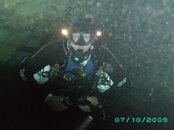Thats fine for heavier steels, but lighter steels and aluminum tanks, the weight makes a large difference and will affect your trim.
Go dive 1/3rds off some AL80s or LP72s and tell me 1/3rd difference in tanks isn't trying to get you cattywompus. Some of the luxfor tanks have noticable bouyancy differences with 1000-1200psi difference as well.
1/3 of an LP 108 at 3600 psi is 49 cu ft of gas - a swing weight of about 3 lbs. 1/6th of an LP 108 is obviously half as much, or 25 cu ft and about a pound and a half.
In comparison 1/3rd of an AL 80 is 25.6 cu ft - basically the same weight and swing weight as 1/6th of an AL 80. So regardless of tank size weight etc, I'm willing to be to my next paycheck that breathing 25 cu ft of gas from an LP 108 results in the same net change in buoyancy as breathing 25 cu ft of gas from an AL 80.
If anything, it makes more sense to use 1/6ths on an LP 108 than it does on an AL 80, given the 3 lb versus 1.5 lb swing weights.
If swapping regulators is too complicated, the diver needs to reevaluate why he's there in the first place.
Oddly enough, many divers beat people with both ends of the task loading bat depending on how it suits them at the moment...but it never makes sense to add task loading when it is not absolutely neccesary and being
able to handle extra task loading when it is not required does not make it smart as it brings with it additional risk if things go south.
Consider something other than diving for a moment. For example, I can fly successful instrument approaches with a partial panel and I did so once on a really bad winter night with substantial ice on the wings where a missed approach was not an option. Obviously being
able to do something is different than
preferring to do something that way. All things being equal, I'd prefer to fly an instrument approach with the whole panel working - particularly with a load of ice on the plane as when things are already tough, I have no desire to make them tougher.
The same thing applies to cave diving. Handling the (minimal) additional task loading is not a problem, but why do it when there is basically no need? There is always the risk that something else will go wrong during the dive creating additonal task loading or distraction. Why voluntarily put more on your plate when you can avoid it?





